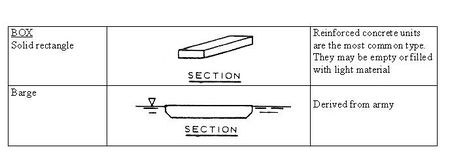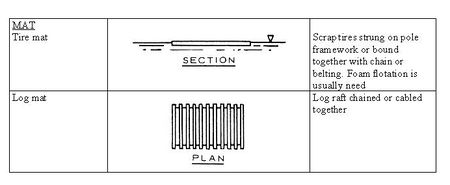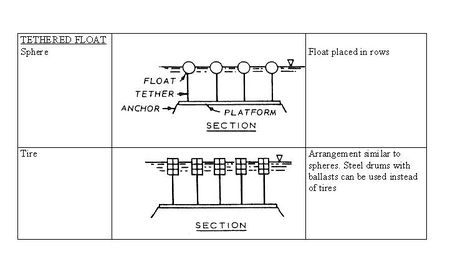Difference between revisions of "Floating breakwaters"
(→Various types) |
(→In practice) |
||
| Line 55: | Line 55: | ||
Tethered float types are seldom used. | Tethered float types are seldom used. | ||
| + | |||
| + | {{author | ||
| + | |AuthorID= | ||
| + | |AuthorName= Piero Ruol}} | ||
Revision as of 11:51, 13 June 2007
Contents
Floating breakwaters
Floating breakwaters represent an alternative solution to protect an area from wave attack, compared to conventional fixed breakwaters and can be effective in coastal areas with mild wave environment conditions. Therefore, they have been increasingly used aiming at protecting small craft harbours or marinas or, less frequently, the shoreline, aiming at erosion control.
Positive points
Some of the conditions that favour floating breakwaters are:
- Poor foundation: Floating breakwaters might be a proper solution where poor foundations possibilities prohibit the application of bottom supported breakwaters.
- Deep water: In water depths in excess of 6 m, bottom connected breakwaters are often more expensive than floating breakwaters.
- Water quality: Floating breakwaters present a minimum interference with water circulation and fish migration.
- Ice problems: Floating breakwaters can be removed and towed to protected areas if ice formation is a problem. They may be suitable for areas where summer anchorage or moorage is required.
- Visual impact: Floating breakwaters have a low profile and present a minimum intrusion on the horizon, particularly for areas with high tide ranges.
- Breakwater layout: Floating breakwaters can usually be rearranged into a new layout with minimum effort.
Effectiveness
Floating breakwaters are very effective when their width is of order of half the wavelength and/or when their natural period of oscillation is much longer compared to the wave period.
The first requirement is seldom verified, and in this case the performance is uncertain. The performance of a floating breakwater depends on the strongly non-linear interaction of the incident wave (that may partially overtop the module and is in general short-crested and oblique) with the structure dynamics. The interaction becomes complicated by the forces induced by the mooring system and the connections between the modules. Accurate design is necessarily based on the combination of numerical and physical models.
Various types
Floating breakwaters are commonly divided into four general categories:
- box,
- pontoon,
- mat,
- tethered float.
For each category, some types of floating breakwaters are shown in Figures 1 - 4. The first three types have been much widely investigated by means of physical models and prototype experience, than the last one.
In practice
Box type breakwaters are used most frequently (Figure 5).
Reinforced concrete modules are either empty inside or, more frequently, have a core of light material (e.g. polystyrene). In the former case the risk of sinking of the structure is not negligible.
Usually dimensions are limited to a width of a few meters.
Connections are either flexible, allowing preferably only the roll along the breakwater axis, or pre or post tensioned, to make them act as a single unit. In the latter case the efficiency is higher, but the forces between modules are also higher. The modular system as applied and the mooring system are primary points of concern for this kind of structures.
Large breakwaters are frequently built with used barges, ballasted to the desired draft with sand or rock.
Pontoon types are effective since the overall width can be of the order of half the wavelength. In this case the expected attenuation of the wave height is significant.
Within the mat category, the most used are made with tires. Although less effective, they have a low cost, they can be removed more easily, they can be constructed with unskilled labour and minimal equipment, they are subjected to lower anchor loads, they reflect less and they dissipate relatively more wave energy.
Tethered float types are seldom used.
Please note that others may also have edited the contents of this article.
|
[[Category:Articles by {{{AuthorFullName}}}]]




